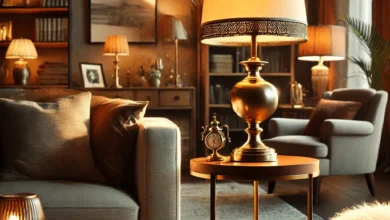Behind the Designs: The Vision and Values of Designer Lighting

Lighting is more than just a functional part of any room; it is an art form that brings warmth, mood, and style into our spaces. Over the years, designer lighting has evolved from being a simple utility to becoming an essential element of interior design. The elegance and sophistication that comes with designer lighting are unmatched, as it serves to illuminate spaces while adding an artistic flair that transforms the entire aesthetic. In this blog, we’ll explore the values, vision, and creativity behind designer lighting and what makes it so special in the world of interior design.
The Essence of Designer Lighting
At its core, designer lighting is about creativity, innovation, and craftsmanship. Unlike mass-produced lighting options, designer lights are created with a vision to complement a space while pushing the boundaries of conventional design. Each piece is a fusion of form, function, and beauty. The designer’s vision often stems from various influences, including art, architecture, nature, and cultural elements. This process ensures that the lighting not only serves its purpose of illuminating a room but also enhances the ambiance and character of the space.
One of the key attributes of designer lighting is the focus on high-quality materials. The use of premium materials ensures that the final product is durable, reliable, and visually stunning. Whether it’s glass, metal, wood, or innovative materials like concrete or fabric, every element is carefully chosen to reflect the designer’s vision. This attention to detail is what makes designer lighting so sought after by homeowners, businesses, and interior designers alike.
The Role of Lighting in Interior Design
Lighting is a fundamental aspect of interior design. It has the power to completely change the perception of a room. The right lighting can make a space feel larger, warmer, and more inviting, while poor lighting can have the opposite effect. When it comes to designer lighting, its role in shaping the overall aesthetic of a space becomes even more important. It’s not just about choosing a light fixture that works well with the décor; it’s about creating a mood and an experience.
In a modern home, designer lighting can serve multiple purposes. It can be used to highlight architectural features, set the tone for a room, and even provide energy-efficient solutions. For instance, in a living room, a designer chandelier or pendant light can become the focal point of the space, drawing the eye upward and creating a striking contrast with the furnishings. Similarly, in a dining room, a designer lighting fixture can create an intimate, warm atmosphere that enhances the dining experience.
Designer lighting often incorporates adjustable features, allowing users to change the intensity and direction of light. This flexibility ensures that the lighting can be adapted to different moods and occasions, from bright task lighting for reading or cooking to soft, ambient lighting for relaxation or entertaining. The versatility of designer lighting is one of the reasons it is so highly valued in modern interior design.
Sustainability and Ethical Design
In today’s world, sustainability has become an essential consideration in design, including lighting. Many designers are increasingly focused on creating energy-efficient lighting solutions that reduce environmental impact while maintaining aesthetic appeal. Sustainable materials like recycled glass, bamboo, and even upcycled metals are being used to craft beautiful, eco-friendly lighting designs.
Ethical design is also a key value that drives the work of many designers. Many seek to ensure that their lighting pieces are produced under fair labor conditions, with a commitment to minimizing waste and using responsible manufacturing processes. The result is not only a beautiful and functional piece but also one that aligns with the values of sustainability and ethical responsibility.
In addition, advancements in technology have enabled designers to create more energy-efficient lighting solutions that use less power and have longer lifespans. LED lights, for example, have become a popular choice in designer lighting because they offer the same brightness as traditional bulbs while using a fraction of the energy and lasting much longer. This commitment to innovation ensures that designer lighting continues to evolve in a way that benefits both the environment and the consumer.
The Impact of Designer Lighting on Ambiance and Mood
The impact of lighting on mood and ambiance cannot be overstated. In fact, lighting plays a significant role in how we feel in a particular space. Have you ever walked into a room with harsh, glaring lights and felt instantly uncomfortable? Or entered a dimly lit space that felt cozy and inviting? The power of lighting to influence our emotions is something that designers tap into when creating their masterpieces.
Designer lighting is particularly effective in setting the right tone for different spaces. In a bedroom, soft, warm lighting can create a calming environment conducive to rest and relaxation. A bedroom with designer lighting will have a tranquil atmosphere, perfect for unwinding after a long day. On the other hand, in a home office, brighter, more focused lighting can increase productivity and enhance concentration. Designer lights are designed with such nuances in mind, allowing the user to tailor their environment to their specific needs.
The ability to control the intensity and color temperature of the lighting is also an important feature of modern designer lighting. Many fixtures now come with adjustable dimmers or smart technology that allows users to change the lighting based on the time of day, mood, or activity. This dynamic aspect of designer lighting ensures that it can always create the perfect atmosphere for any occasion.
The Designer’s Vision: Merging Art and Functionality
One of the most exciting aspects of designer lighting is the seamless blend of art and functionality. A great lighting designer is not just a craftsman; they are an artist. They take inspiration from their surroundings, from the latest trends in interior design, and from the timeless beauty of nature. The result is lighting that doesn’t just illuminate a space but transforms it.
For example, some lighting designers may take inspiration from the flowing forms of nature, such as the curves of a tree branch or the undulating waves of the ocean. These organic forms are often reflected in the design of the light fixture itself, creating a sense of harmony between the natural world and the built environment. This blend of artistry and practicality is what makes designer lighting so unique and sought after.
Moreover, lighting is one of the few design elements that has both aesthetic and functional purposes. While a piece of designer furniture or artwork may serve purely as a visual statement, designer lighting must also work to illuminate a space. The balance between form and function is a hallmark of great design, and it’s what makes designer lighting a key player in the world of interior design.
The Value of Customization in Designer Lighting
Another important aspect of designer lighting is the opportunity for customization. Many designers offer bespoke lighting solutions that are tailored to the specific needs and tastes of the client. This level of personalization allows homeowners and businesses to have a piece that fits perfectly within their space, both in terms of size and style.
Custom lighting designs can be particularly useful in challenging or unique spaces, such as high-ceilinged rooms, narrow hallways, or outdoor areas. The ability to tailor the lighting to the specific dimensions and requirements of the space ensures that the final product is both functional and aesthetically pleasing. Customization also allows for the integration of specific colors, materials, and features that reflect the client’s personality and vision.
For example, a client might want a chandelier that incorporates specific crystals or glass elements to match their existing décor. Alternatively, they might desire a fixture that includes adjustable lighting angles to create different moods in the room. Designer lighting, with its customization options, allows for the realization of these personalized details, making it a perfect choice for anyone looking to create a truly unique environment.
Conclusion
In conclusion, designer lighting is much more than just a functional element of interior design. It is a creative expression, a reflection of vision, and a tool for enhancing the atmosphere and functionality of a space. From the use of premium materials to the thoughtful design process that merges art with functionality, designer lighting plays a critical role in shaping the aesthetic of any room. Its impact on mood and ambiance is significant, and the ability to customize each piece ensures that it can meet the unique needs of any individual or space.
Lighting is one of the most powerful tools in the interior designer’s toolkit. Whether it’s creating a warm, inviting environment or highlighting specific design features, designer lighting helps bring a space to life in ways that other elements simply cannot. When you invest in designer lighting, you’re not just buying a product; you’re bringing a piece of art into your home or office that will continue to inspire and transform your space for years to come.
FAQs
- What makes designer lighting different from regular lighting? Designer lighting is crafted with creativity, premium materials, and attention to detail. Unlike mass-produced lighting, it focuses on both aesthetics and functionality, offering unique and customizable options.
- How can designer lighting enhance the ambiance of a room? The right designer lighting can set the tone for a space, from creating a warm, inviting atmosphere to energizing a room for productivity. Its ability to adjust light intensity and color temperature allows for mood customization.
- Is designer lighting energy-efficient? Many designer lighting pieces use energy-efficient technologies, such as LED lights, which offer the same brightness while consuming less energy and lasting longer.
- Can I customize designer lighting to fit my space? Yes, many designers offer bespoke solutions that can be tailored to the specific needs, dimensions, and style preferences of a client, allowing for a truly unique lighting design.
- How do I choose the right designer lighting for my space? Consider the size, function, and style of the room. Think about how you want to feel in the space and how the lighting can enhance the mood. Consulting with a lighting designer can also help guide your decisions.
Please don’t forget to leave a review.
Explore more by joining me on BuyMeACoffee / Patreon


